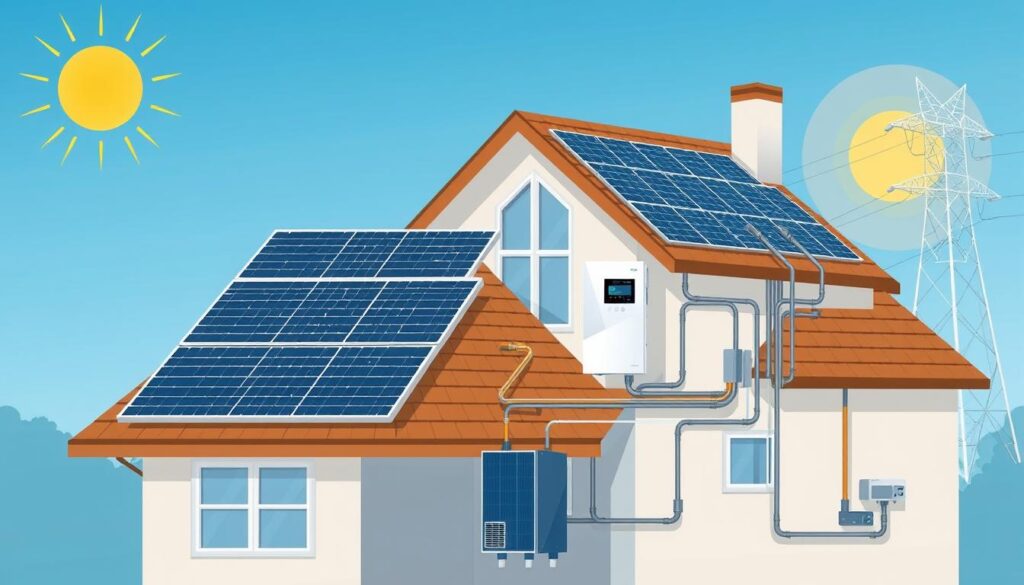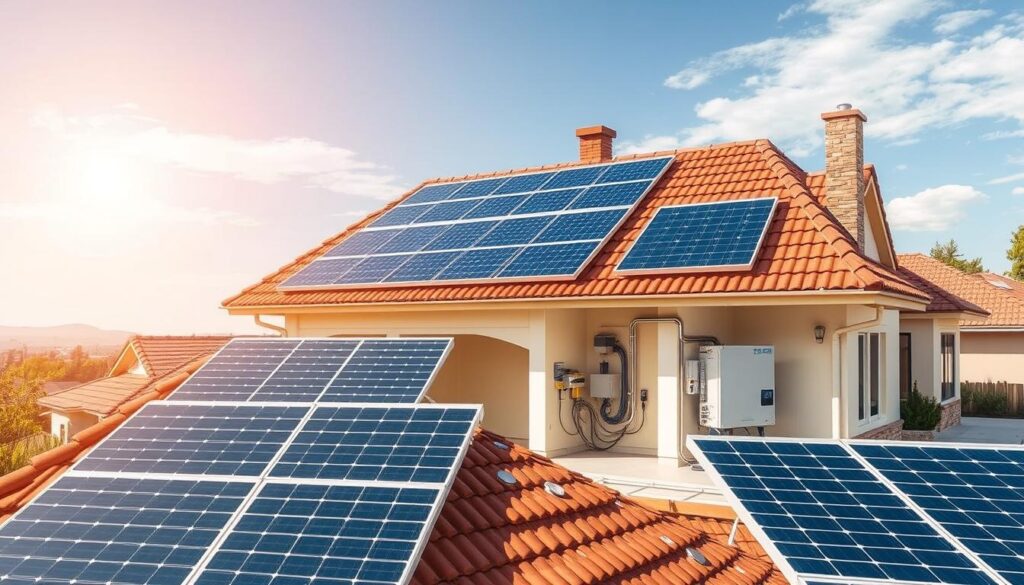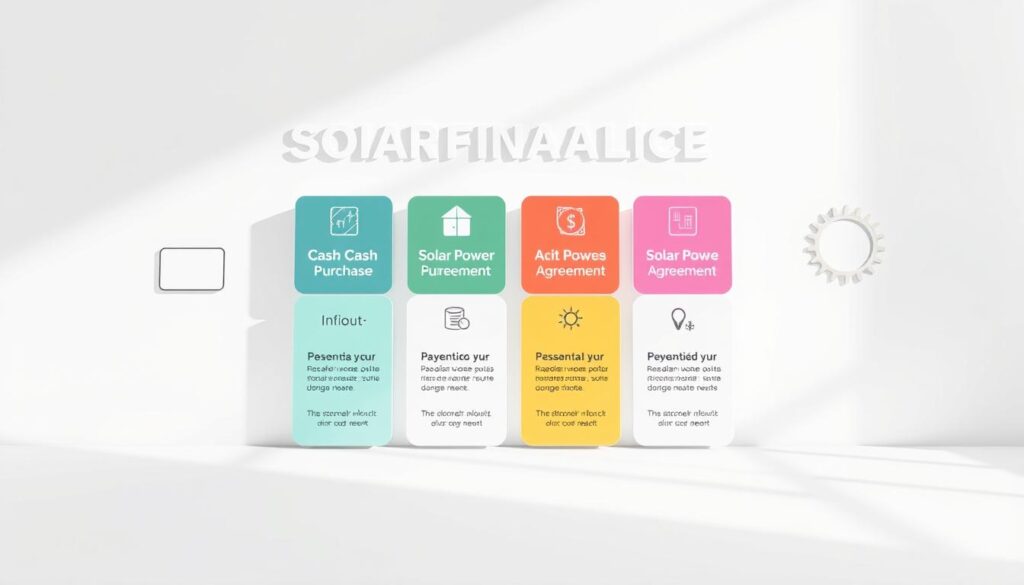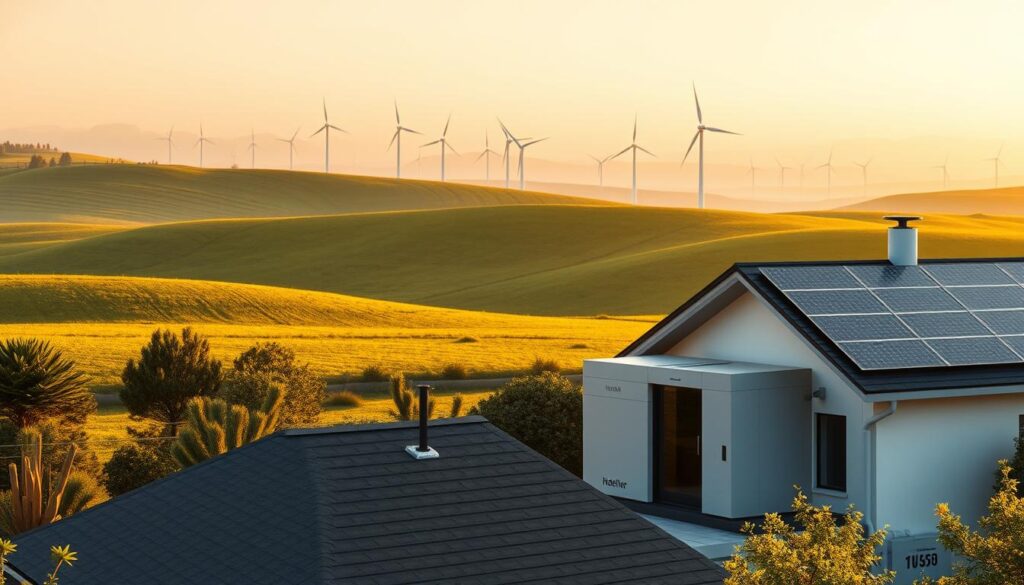Are you looking for a smart way to reduce your electricity bills while embracing clean energy? A solar panel system might be the perfect solution. With advancements in technology and government incentives, now is an ideal time to explore this renewable energy option.
Investing in a solar power setup can lead to significant long-term savings. According to the Department of Energy, many homeowners are already enjoying lower utility costs and increased energy independence. Plus, solar panels are designed to last for decades, making them a reliable investment in your future.
Beyond financial benefits, switching to solar energy helps reduce your carbon footprint. It’s a practical step toward a more sustainable lifestyle. This article will guide you through the basics, installation tips, and financing options to help you make an informed decision.
Key Takeaways
- Solar panels can significantly reduce electricity bills and provide long-term savings.
- Government incentives make investing in solar energy more affordable.
- Solar power systems are durable and require minimal maintenance.
- Switching to solar helps reduce your carbon footprint.
- This guide covers installation, financing, and case studies to help you get started.
Understanding Home Solar Array Systems
Curious about how solar energy systems work and what makes them efficient? Let’s break it down into simple terms. A solar array is a collection of panels wired together to generate direct current (DC) power. These panels are the heart of any solar setup, converting sunlight into usable electricity.
What is a Solar Array?
A solar array is essentially a group of solar panels connected to form a single unit. Each panel contains photovoltaic (PV) cells, which absorb sunlight and convert it into electricity. This DC power is then sent to an inverter, transforming it into alternating current (AC) for household use.
Key Components and Terminology
Understanding the parts of a solar energy system can help you make informed decisions. Here are the main components:
- Photovoltaic Cells: These are the building blocks of a solar panel, responsible for converting sunlight into electricity.
- Inverter: This device changes DC power from the panels into AC power for your home.
- Balance of System (BOS): Includes wiring, mounting hardware, and other parts that complete the setup.
Together, these components form a complete energy system that powers your home efficiently. Whether you’re considering a residential or commercial installation, knowing these terms can help you navigate the process with confidence.
How a Home Solar Array Works
Ever wondered how sunlight transforms into usable electricity for your household? The process is both fascinating and straightforward. Let’s dive into the mechanics of energy creation and conversion, along with key installation tips to ensure optimal performance.
Energy Creation and Conversion Process
At the heart of every solar panel are photovoltaic (PV) cells. These cells capture sunlight and convert it into direct current (DC) electricity. This is the first step in the energy production process.
Next, the DC electricity flows to an inverter. This device transforms it into alternating current (AC), which powers your home appliances. Without the inverter, the electricity generated by the panels wouldn’t be usable for most household needs.

- Sunlight hits the solar panels, activating the PV cells.
- DC electricity is produced and sent to the inverter.
- The inverter converts DC into AC electricity.
- AC electricity powers your home or feeds into the grid.
Installation Considerations
When installing solar, several factors can impact the efficiency of your system. Here are the key considerations:
| Factor | Optimal Choice |
|---|---|
| Direction | South-facing panels maximize sunlight exposure. |
| Tilt Angle | Adjust based on your latitude for peak efficiency. |
| Mounting | Roof or ground mounting depends on space and sunlight access. |
Additionally, oversizing your system can save on future costs, while using microinverters or power optimizers enhances efficiency in complex setups.
“The average lifespan of solar panels is over 25 years, making them a reliable long-term investment.”
By understanding these factors, you can ensure your solar power system operates at its best for decades.
Benefits of Solar Energy for American Homeowners
Discover how switching to solar can transform your energy use and wallet. Solar energy offers a dual advantage: it’s both eco-friendly and cost-effective. By harnessing the power of the sun, you can reduce your carbon footprint while enjoying significant savings on your electricity bills.
Environmental and Financial Advantages
One of the most compelling reasons to go solar is its positive impact on the environment. Switching to renewable energy reduces greenhouse gas emissions, equivalent to planting 125 trees annually. It also decreases reliance on fossil fuels, which contribute to air pollution and climate change.
Financially, solar power systems can lead to substantial savings. According to the Department of Energy, homeowners can save between $25,000 to over $110,000 over the system’s lifetime. Additionally, homes with solar installations sell for an average of 4% more than those without.
- Lower monthly electricity bills by generating your own power.
- Increase property value with a reliable energy system.
- Enjoy long-term savings and a quicker payback period, often within 6 to 12 years.
By investing in solar energy, you’re not just saving money—you’re contributing to a cleaner, more sustainable future. Whether you’re looking to reduce your energy costs or make a positive environmental impact, solar power is a smart choice for homeowners across the U.S.
Comparing Grid-Tied and Off-Grid Solar Options
Choosing the right solar setup depends on your energy needs and location. Two primary options are grid-tied and off-grid systems. Each has unique advantages and limitations, making them suitable for different scenarios. Let’s explore these configurations to help you decide which one fits your lifestyle.
Advantages of Grid-Tied Systems
A grid-tied system connects to the local utility grid, allowing you to use both solar power and grid electricity. One of its biggest benefits is net metering. Excess energy generated by your solar panels is sent back to the grid, earning you credits on your utility bill.
Grid-tied systems are cost-effective and require less equipment. They don’t need batteries, which reduces upfront costs. According to industry data, these systems typically range from $25,000 to $55,000, making them an affordable option for many homeowners.
- Lower installation costs due to fewer components.
- Earn credits through net metering for excess energy.
- Reliable power supply by combining solar and grid electricity.
Benefits of Off-Grid Configurations
Off-grid systems are ideal for remote locations where utility access is unavailable. They operate independently, relying solely on solar power and battery storage. This setup provides complete energy independence, making it a great option for those seeking self-sufficiency.
However, off-grid systems require more equipment, including batteries, charge controllers, and inverters. This increases the overall cost, often exceeding $75,000. Additionally, you’ll need to monitor energy consumption to ensure a consistent power supply.
- Complete independence from the utility grid.
- Ideal for remote or rural areas without grid access.
- Higher upfront costs due to additional equipment.
Both grid-tied and off-grid systems have their place. Grid-tied setups are cost-effective and practical for most homeowners, while off-grid configurations offer independence for remote locations. Consider your energy needs, location, and budget to choose the best option for your situation.
Planning Your Solar Energy Investment
Ready to take control of your energy future? Planning your solar investment starts with understanding your needs. A well-thought-out approach ensures you get the most out of your solar energy system. Let’s walk through the steps to assess your energy usage and calculate the right system size for your household.

Assessing Your Energy Needs
Begin by reviewing your utility bills to understand your current energy consumption. Look for your average monthly kilowatt-hour (kWh) usage. This number is crucial for determining the size of the system you’ll need.
Next, consider your future energy needs. Are you planning to add appliances or expand your home? Factor these into your calculations to avoid undersizing your setup.
- Review 12 months of utility bills for accurate usage data.
- Identify peak usage months to account for seasonal variations.
- Consider future changes in your household’s energy consumption.
Calculating System Size and Savings
Once you know your energy needs, it’s time to calculate the size of your system. A simple formula can help: divide your annual kWh usage by the average sunlight hours in your area. This gives you the kilowatt (kW) capacity required.
For example, if your home uses 10,000 kWh annually and your area gets 4 peak sunlight hours per day, you’ll need a 6.85 kW system (10,000 ÷ 4 ÷ 365).
| Factor | Example |
|---|---|
| Annual kWh Usage | 10,000 kWh |
| Peak Sunlight Hours | 4 hours/day |
| System Size | 6.85 kW |
Compare the upfront costs with your estimated savings. On average, homeowners save $25,000 to $110,000 over the system’s lifetime. Use online calculators or consult a professional for precise figures.
“Proper planning ensures your solar investment meets your energy needs and maximizes savings.”
By following these steps, you’ll be well-prepared to make an informed decision. Take your time, gather all the necessary data, and consult experts if needed. A well-planned system is the key to a successful energy investment.
Step-by-Step Guide to Installing a Home Solar Array
Thinking about taking the DIY route for your energy setup? Here’s a step-by-step guide to help you get started. Whether you’re a seasoned DIYer or a beginner, installing your own system can be a rewarding project. Let’s explore your options and walk through the process.
Roof-Mounted vs Ground-Mounted Options
Choosing between roof-mounted and ground-mounted systems depends on your space and needs. Roof-mounted panels are popular for their space efficiency. They use existing structures, saving on additional materials. However, they require a sturdy roof and proper angle for optimal energy production.
Ground-mounted systems, on the other hand, offer flexibility in placement. They’re ideal for properties with ample land and can be adjusted for the perfect tilt. While they require more space and materials, they’re easier to access for maintenance.
- Roof-Mounted: Space-efficient, uses existing structures, requires a sturdy roof.
- Ground-Mounted: Flexible placement, easier maintenance, needs more space.
DIY Installation Tips and Best Practices
Ready to start your project? Here are some tips to ensure a smooth installation. First, gather all necessary tools, including a drill, wrench, and safety gear. Always check local permits and regulations before beginning.
Start by mounting the panels securely. For roof-mounted systems, ensure the roof can support the weight. Use proper brackets and sealants to prevent leaks. For ground-mounted setups, prepare a stable foundation with concrete and mechanical tubing.
Next, connect the wiring. Use insulated lugs or approved splicing devices for DC connections. Follow the National Electric Code (NEC) guidelines for safety. Finally, install the inverter in a cool, well-ventilated area for optimal performance.
- Check local permits and regulations before starting.
- Use proper mounting hardware and sealants for roof installations.
- Prepare a stable foundation for ground-mounted systems.
- Follow NEC guidelines for wiring and safety.
“Proper planning and safety measures are key to a successful DIY installation.”
By following these steps, you’ll be well on your way to a successful DIY project. Remember, taking your time and prioritizing safety will ensure your system operates efficiently for years to come.
Financing Your Solar Power System
Ready to explore how financing can make your energy goals a reality? Investing in a system doesn’t have to be overwhelming. With the right plan, you can manage costs while enjoying long-term savings. Let’s break down the financial aspects to help you make an informed decision.

Cost Breakdown and Equipment Investment
The average cost of a complete system ranges from $18,000 to $20,000 before incentives. This includes equipment like panels, inverters, and mounting hardware. Installation costs vary based on your location and the complexity of the setup.
Here’s a quick breakdown of expenses:
- Equipment: Panels, inverters, and batteries make up 60-70% of the total cost.
- Installation: Labor and permits account for the remaining 30-40%.
- Maintenance: Annual cleaning costs range from $15 to $30 per panel.
While the upfront cost may seem high, the long-term savings are significant. Over 25 years, you could save $25,000 to $110,000 on electricity bills.
Available Incentives and Savings Opportunities
Federal and state incentives can reduce your investment by thousands of dollars. The federal solar tax credit (ITC) offers a 30% credit on the total cost of your system. This means a $20,000 setup could qualify for a $6,000 tax credit.
Many states also offer additional rebates and incentives. For example, Austin, Texas, provides a $2,500 rebate for homeowners who complete a solar education course. Check your local programs to maximize your savings.
Here are some financing options to consider:
- Loans: Personal loans or home equity loans can cover upfront costs with fixed monthly payments.
- Leases: Pay a fixed monthly fee to use the system without owning it.
- Power Purchase Agreements (PPAs): Pay for the electricity generated at a lower rate than your utility bill.
“The federal solar tax credit can reduce your upfront costs by 30%, making renewable energy more accessible.”
By exploring these options, you can find a financial plan that fits your budget. Whether you choose a loan, lease, or PPA, the key is to compare upfront costs with long-term savings. With the right strategy, your investment will pay off for decades to come.
Maximizing Solar Energy Storage and Net Metering
Looking to enhance your energy setup with advanced solutions? Integrating battery storage and leveraging net metering can take your system to the next level. These tools not only improve efficiency but also ensure reliability and cost savings.

Battery Storage Solutions
Battery storage is a game-changer for energy systems. It allows you to store excess power generated during sunny periods for use during cloudy days or outages. This ensures a consistent energy supply, even when the sun isn’t shining.
Modern batteries are designed to last for years and require minimal maintenance. They also help reduce reliance on the grid, providing greater energy independence. For example, during peak demand times, stored energy can be used instead of purchasing expensive electricity from utilities.
- Store excess energy for use during outages or low sunlight periods.
- Reduce reliance on the grid, increasing energy independence.
- Minimize costs by using stored energy during peak demand times.
Leveraging Net Metering Benefits
Net metering is another powerful tool for maximizing your energy investment. When your system generates more power than you use, the excess is sent back to the grid. In return, you earn credits on your utility bill.
These credits can offset future electricity costs, making your system even more cost-effective. For instance, in Colorado, homeowners with net metering can significantly reduce their monthly bills. Combining battery storage with net metering ensures you get the most out of your energy system.
“Net metering allows homeowners to earn credits for excess energy, reducing overall electricity costs.”
- Earn credits for excess energy sent back to the grid.
- Offset future electricity bills, maximizing savings.
- Combine with battery storage for enhanced energy independence.
By integrating battery storage and leveraging net metering, you can optimize your energy system for efficiency, reliability, and savings. These solutions are key to making the most of your renewable energy investment.
Case Studies and Real-World Applications
Real-world examples can inspire confidence in adopting renewable energy solutions. From residential setups to large-scale commercial projects, these success stories demonstrate the tangible benefits of solar panels. Let’s explore how these systems are transforming lives and businesses.
Residential Installations Success Stories
Many homeowners are reaping the rewards of their energy investments. For instance, the Lavallee family in Rhode Island installed a 9.5 kW system, achieving a 34.9% return on investment. Their annual savings of $3,845 have made the switch to solar a financially sound decision.
Another example is the Götz family in Germany, who reduced their energy costs by €3,936 annually with an 8.5 kW setup. These stories highlight how solar panels can significantly lower electricity bills while contributing to a greener planet.
- Lavallee Family: 9.5 kW system, $3,845 annual savings.
- Götz Family: 8.5 kW system, €3,936 annual cost reduction.
- Tan Family: 18.6 kW system, SGD $6,000 estimated annual savings.
Lessons from Commercial Projects
Commercial projects also showcase the scalability and efficiency of solar power. Absolute Coatings in New York installed an 82 kW system, saving $442,866 over its lifetime. Similarly, Rehme Steel in Texas achieved $338,883 in savings with their 81.6 kW setup.
These projects demonstrate that businesses of all sizes can benefit from solar energy. Challenges like initial costs and installation logistics are outweighed by long-term savings and environmental impact.
“Commercial solar installations not only reduce costs but also enhance corporate sustainability goals.”
- Absolute Coatings: 82 kW system, $442,866 lifetime savings.
- Rehme Steel: 81.6 kW system, $338,883 estimated savings.
- Birkhof Horse Stables: 34.68 kW system, €12,954 annual cost reduction.
Whether for a home or a business, these case studies prove that solar panels are a reliable and cost-effective solution. By learning from these real-world applications, you can make an informed decision about your own energy future.
Conclusion
Switching to renewable energy is a smart step toward a sustainable future. By investing in a system, you can reduce your electricity bills and contribute to a cleaner environment. The financial and environmental benefits make it a worthwhile investment for homeowners across the U.S.
From planning to installation, the process is straightforward with the right guidance. Tools like battery storage and net metering enhance efficiency and savings. Many families and businesses have already seen significant reductions in their energy costs.
Take the first step today. Research your options, consult professionals, and explore incentives. Investing in a system is not just about savings—it’s about securing a brighter, greener future for generations to come.
